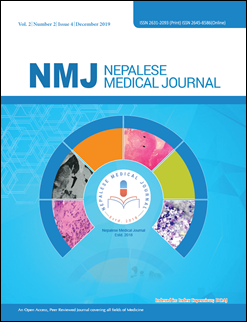Overlap of Sleep Disorders and Chronic Respiratory Diseases: An Emerging Health Dilemma
DOI:
https://doi.org/10.3126/nmj.v2i2.26007Keywords:
Overlap Syndrome, Sleep Disorders, Respiratory DiseasesAbstract
Introduction: The burden of Overlap Syndrome (coexistence of sleep-related breathing disorders in patients with respiratory diseases) is high in developing countries, and such a phenomenon implies higher morbidity. The study was conducted to measure the prevalence of sleep-related breathing disorders in patients with Respiratory Symptom Complex and to identify factors associated with the severity of sleep-related breathing disorders.
Materials and Methods: A hospital-based cross-sectional study of 50 patients with respiratory symptom complex was conducted at BP Koirala Institute of Health Sciences. Structured proforma and Polysomnography were used for analysis.
Results: There were 24 patients (48%) with COPD, 18 (36%) with Bronchial Asthma. 6 patients (12%) with Bronchiectasis and 2 patients with Interstitial Lung Disease. 60% (n=30) patients had sleep-related breathing disorder or Overlap syndrome, 14 patients (46.67%) had mild sleep-related breathing disorder while 16 (53.33%) patients had moderate to severe type. 62.5% COPD patients, 55.55% Bronchial Asthma patients, 50% of patients with Interstitial Lung Disease and 50% Post-TB Bronchiectasis patients had a sleep-related breathing disorder. There was a significant positive correlation between the presence of sleep-related breathing disorder in patients with respiratory symptom complex and high neck circumference (0.499, p-value <0.001), waist circumference (0.293, p-value = 0.039) and hip circumference (0.371, p-value = 0.008).
Conclusions: Overlap Disorders comprising sleep disorders in patients with chronic respiratory diseases are high in developing countries. Routine sleep history and polysomnography in all patients with Respiratory Symptom Complex can detect sleep-related breathing disorders.
Downloads
Downloads
Published
How to Cite
Issue
Section
License
This license enables reusers to distribute, remix, adapt, and build upon the material in any medium or format, so long as attribution is given to the creator. The license allows for commercial use.
Copyright on any article published by Nepalese Medical Journal is retained by the author(s).
Authors grant Nepalese Medical Journal a license to publish the article and identify itself as the original publisher.
Authors also grant any third party the right to use the article freely as long as its integrity is maintained and its original authors, citation details and publisher are identified.




